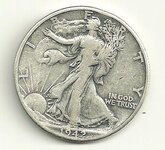Sandigger2
Sr. Member
- Mar 25, 2012
- 279
- 105
- Detector(s) used
- DFX, PIDF,CZ 21,F5,
- Primary Interest:
- Beach & Shallow Water Hunting
My oldest coin find is my avatar (1904 O) big silver found at approx 2-3 inches under a porch that was being replaced on a1920's Craftsman. I mostly beach hunt where depth is
everything, one of the reasons I have a pulse machine for after storms and when the depositors are not contributing.
everything, one of the reasons I have a pulse machine for after storms and when the depositors are not contributing.












